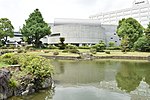Tokyo Opera City Tower

Tokyo Opera City Tower (東京オペラシティタワー, Tōkyō Opera Shiti Tawā) is a skyscraper located in Shinjuku, Tokyo, Japan. Completed in 1996, it stands 234 metres (768 feet) high and has 54 floors. The tower is the third-tallest building in Shinjuku, Tokyo and seventh-tallest in Tokyo. The closest train station to Opera City is Hatsudai. The building houses concert halls, an art gallery, a media-art museum (NTT InterCommunication Center) and many restaurants and shops on its lower floors. The fifth through fifty-second floors are devoted to office space. The building is adjacent to the New National Theater, which is located in Shibuya, Tokyo. The combined complex of the tower and the theatre is called the "Tokyo Opera City".
Excerpt from the Wikipedia article Tokyo Opera City Tower (License: CC BY-SA 3.0, Authors, Images).Tokyo Opera City Tower
Central Circular Route, Shinjuku
Geographical coordinates (GPS) Address Website Nearby Places Show on map
Geographical coordinates (GPS)
| Latitude | Longitude |
|---|---|
| N 35.68356 ° | E 139.68654 ° |
Address
トモズ
Central Circular Route
163-1490 Shinjuku
Japan
Open on Google Maps









